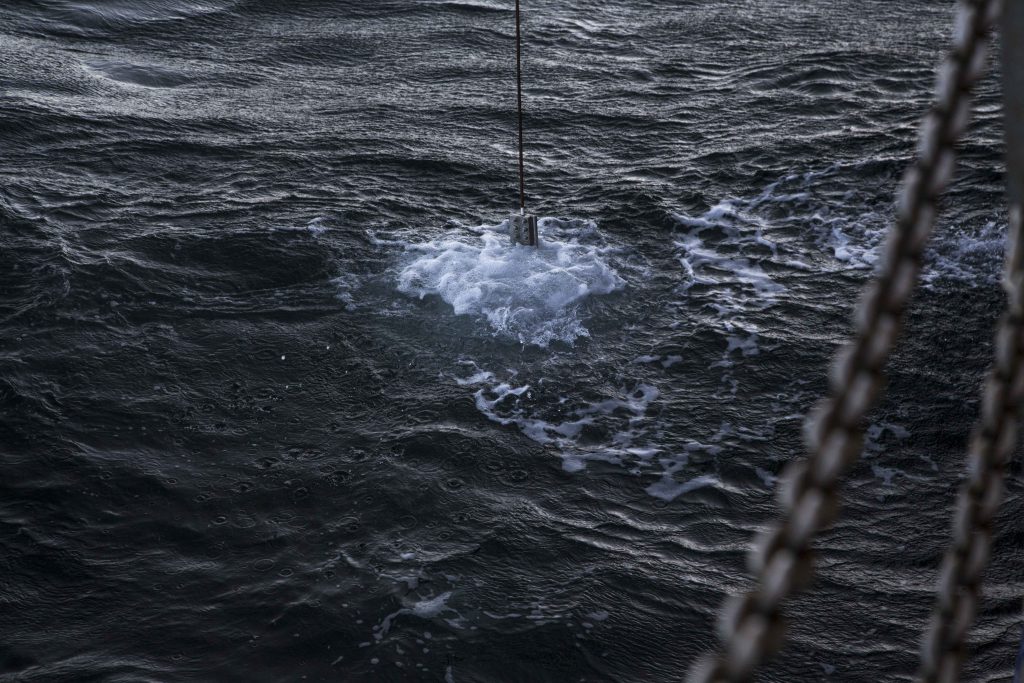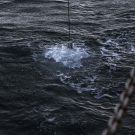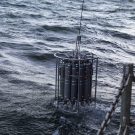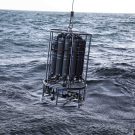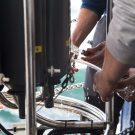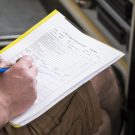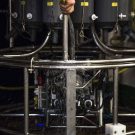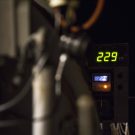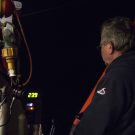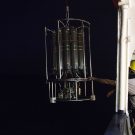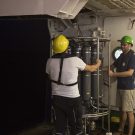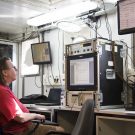Three times a day, water samples are taken on the R/V POSEIDON using the CTD rosette. CTD stands for conductivity, temperature, and depth, which is determined by measuring the pressure. CTD sampling provides a vertical profile of the water and brings water from different depths to the surface. The CTD rosette on board consists of 12 bottles, which can be automatically closed to obtain certain depths from which a sample of water is needed for examination. Among the bottles is a pump that provides a constant flow of water to the various sensors. Sensors for measuring the conductivity, which can be used to determine the salt content, for the determination of gases, such as O2 and CO2, chlorophyll content, and temperature, as well as a cell for measuring the water pressure are permanently installed on the CTD rosette.
Procedure at a CTD station:
First, the bottles are emptied. The water from the last measurements remains in the bottles until then, as otherwise salt crystals and nutrients would settle in the bottles, contaminating the next sample. Next, the bottles are re-tensioned, so that they can be triggered at the appropriate depth and thus closed. Then the CTD is launched into the water. Two persons from the crew manage the launch and the boatswain stands outside to operate the winch lowering the CTD in the water. The bridge, laboratory, and crew outside with the CTD rosette are in permanent radio contact. In the dry laboratory, it is possible to monitor how deep the CTD is sinking on a screen. The rosette can be lowered and retrieved at speeds from 0.5 to 1 meter per second. In the laboratory, various research units discuss the depth at which water samples are needed. These are written down by the CTD driver. This protocol is entered into a station log, which records the start and end times, the coordinates at the beginning and end of the measurement, and the depth of the sea at the location of the CTD launching. In another protocol, the desired depths are assigned to the individual bottles. When this depth is reached, the respective bottle is automatically closed by the CTD driver. In addition to the depth, the values measured by the various sensors can be determined on the screen. The individual measured values of the gases, nutrients and chlorophyll are displayed with different colored lines. These give a clue of which water depth samples are needed. On the way from bottom to top, the samples are taken.
When the CTD reaches the surface of the water, it is taken to the deck by the crew and lashed down to protect it against the rolling of the sea. The salt water is rinsed off the devices, sensors and bottles with fresh water. Then the first water samples can be taken. The first sample taken is the oxygen sample. In the beginning, the bottle is completely filled with water. When water is removed, air flows into the bottle from above. This causes a gas exchange between air and water. Since the bottles are never 100% tight, it is important that the gas samples are taken in a timely manner to prevent outgassing/ingassing and falsification of the values. Oxygen (O2) is the most sensitive gas, making it the first sample. This is followed by further sampling for other gases, followed by nutrients and chlorophyll, as these substances stay in the water for longer. For the chlorophyll samples, it is important that the bottles are stored dark and cold until analysis, otherwise the measured values will be incorrect. At the end, if necessary, samples can be taken for salt determination, as this is the least sensitive to contamination.
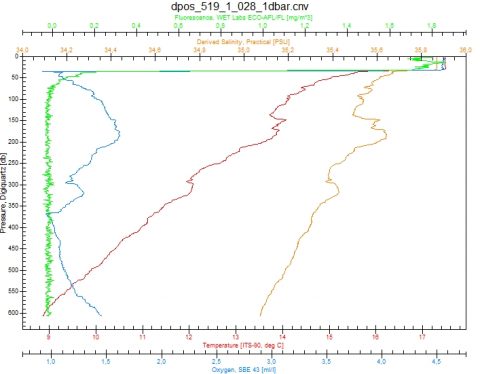
Plot of the CTD _ 02.02.2018 at 09.59 UTC
The CTD measurements on board take place at 8 o’clock in the morning, 4 o’clock in the afternoon and the last one at midnight. After the measurement on Thursday afternoon, we will cross the upwelling patch from east to west. This journey is expected to take 24 hours, during which only underway samples will be taken. For us this means a moment of rest and relaxation after the work-intensive last days, without much sleep.
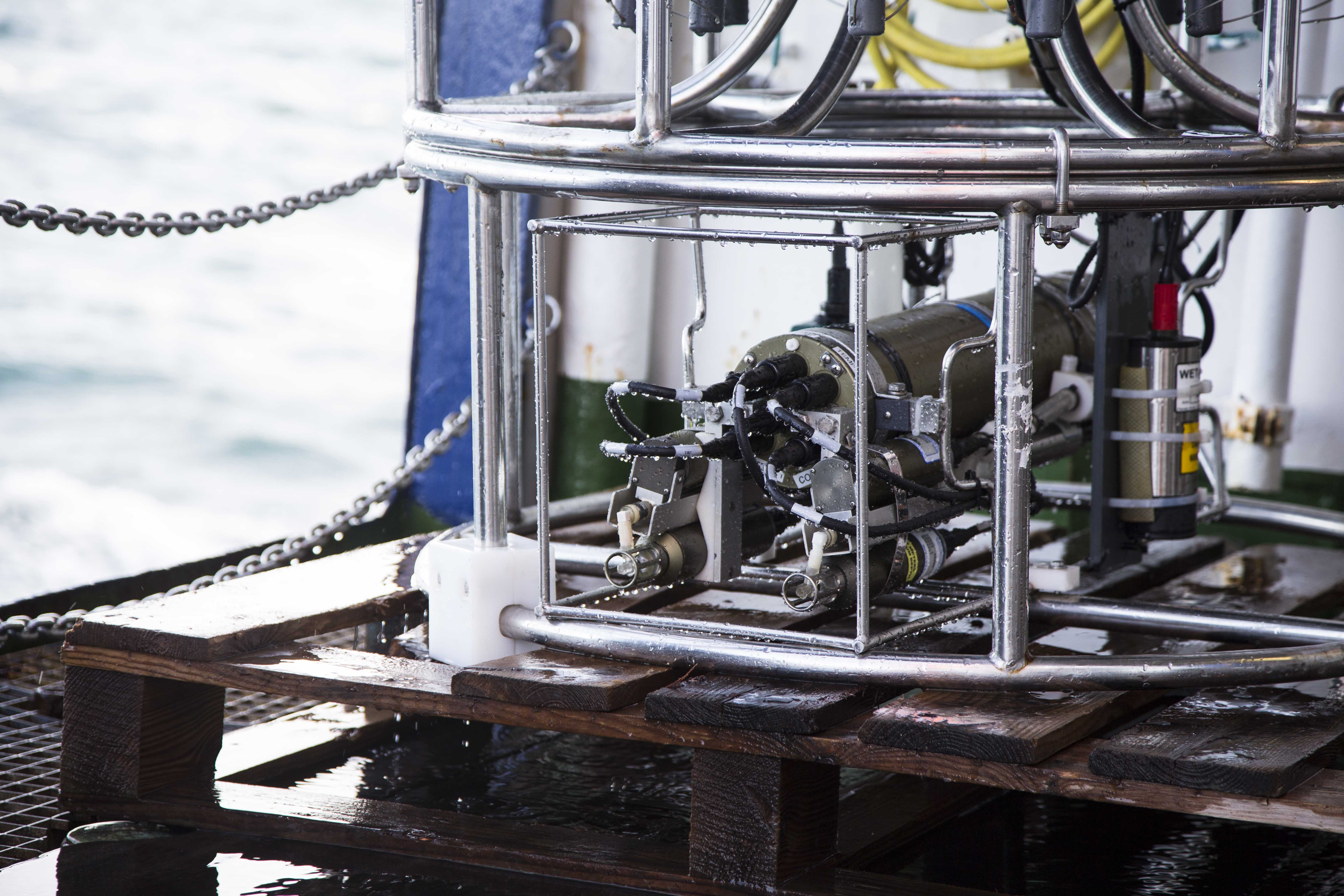
The pump with the different sensors of the CTD. Die Pumpe mit den verschiedenen Sensoren am CTD. (CCredit: Lisa Hoffmann, CC BY-NC-ND)
Dreimal am Tag werden auf der F/S POSEIDON Proben mit Hilfe der CTD genommen. CTD steht für Conductivity, Temperature, Depth, auf Deutsch Leitfähigkeit, Temperatur und Tiefe, die durch den Druck gemessen wird. Ein CTD liefert ein vertikales Profil der Wassertemperatur und des Salzgehaltes und bringt aus verschiedenen Tiefen Wasser mit an die Oberfläche.
Die CTD an Bord besteht aus 12 Flaschen, auch Schöpfern genannt, die automatisch vom „Fahrer“ der CTD in beliebigenen Tiefen geschlossen werden können, je nachdem, aus welcher Tiefe eine Wasserprobe zur Untersuchung benötigt wird. Unter den Schöpfern befindet sich eine Pumpe, die für einen konstanten Wasserfluss für die verschiedenen Sensoren sorgt. Diese Sensoren messen die Leitfähigkeit, mit Hilfe derer der Salzgehalt bestimmt werden kann, und die Wassertemperatur. Außerdem gibt es Sensoren zur Bestimmung von Sauerstoff und des Chlorophyll-Gehalts, sowie eine Zelle zur Messung des Wasserdrucks.
Ablauf einer CTD-Station
Zunächst werden die Flaschen geleert. Das Wasser der letzten Messungen bleibt bis dahin in den Flaschen, da sonst zurückbleibende Salzkristalle und Nährstoffe sich in diesen festsetzen würden. Dann werden die Flaschen neu gespannt, damit sie in entsprechender Tiefe ausgelöst und somit geschlossen werden können.
Dann wird die CTD zu Wasser gelassen. Zwei Matrosen von der Crew setzen diese aus und am Außenstand bedient ein weiterer Matrose die Winde. Brücke, Labor und Außenstand stehen in permanenten Funkkontakt. Im Trockenlabor kann auf dem Monitor verfolgt werden, wie tief die CTD absinkt. Von 0,5 bis 1 Meter pro Sekunde kann diese gefiert oder gehievt werden. Im Labor wird von den verschiedenen Forschungseinheiten besprochen, aus welcher Tiefe Wasserproben benötigt werden, diese werden vom CTD-Fahrer aufgeschrieben. Dieser führt zudem ein Stationsprotokoll, in dem die Anfangs- und Endzeit, die Koordinaten bei Anfang und Ende der Messung, sowie die Meerestiefe am Ort der CTD-Fahrt aufgenommen werden. In einem weiteren Protokoll werden die gewünschten Tiefen den einzelnen Flaschen zugeordnet. Wird diese Tiefe erreicht, wird die jeweilige Flasche automatisch vom CTD-Fahrer geschlossen. Auf einem Monitor werden neben der Tiefe auch die Messwerte der verschiedenen Sensoren dargestellt. In verschieden farbigen Linien werden die einzelnen Messwerte der Gase, Nährstoffe und des Chlorophylls angezeigt. Diese geben einen Anhaltspunkt, aus welcher Wassertiefe Proben benötigt werden. Auf dem Weg von unten nach oben werden die Proben dann genommen.
Wenn die CTD die Wasseroberfläche erreicht, wird sie von der Crew an Deck geholt und dort gegen Verrutschen durch Seegang gelascht. Im Anschluss wird zunächst mit Frischwasser das Salzwasser von den Geräten, Sensoren und Flaschen abgespült. Dann können die ersten Wasserproben genommen werden.
Als erste Probe wird die Sauerstoffprobe genommen. Am Anfang ist der Schöpfer komplett mit Wasser gefühlt. Wird Wasser entnommen, strömt von oben Luft in die Flasche. Dadurch kommt es zu einem Gasaustausch zwischen Luft Wasser. Da die Flaschen nie hundertprozentig dicht sind, ist es wichtig, dass die Proben zur Gasbestimmung zeitnah entnommen werden, damit es nicht zum Ausgasen kommt und die Werte verfälscht werden. Sauerstoff ist am empfindlichsten und ist dadurch die erste Probe. Dann folgen weitere Entnahmen für weitere Gase und im Anschluss Nährstoffe und Chlorophyll, da sich deren Konzentration im Wasser nicht so schnell ändert. Bei der Entnahme der Chlorophyll-Probe ist es wichtig, dass die Flaschen im Anschluss bis zur Analyse dunkel und kalt gelagert werden, da sonst die Werte verfälscht werden. Am Ende können bei Bedarf Proben zur Bestimmung des Salzgehaltes genommen werden, da dieses am unempfindlichsten ist und nicht viel verfälscht werden kann.
Die CTD Messungen an Bord finden um 8 Uhr morgens, 4 Uhr nachmittags und zuletzt um Mitternacht statt. Heute steht nach der Messung am Nachmittag die Kreuzung des Patches von Ost nach West statt. Diese Fahrt wird voraussichtlich 24 Stunden in Anspruch nehmen, in denen nur Underway-Proben genommen werden. Ein Moment der Ruhe und Erholung nach den arbeitsintensiven letzten Tagen mit wenig Schlaf.
